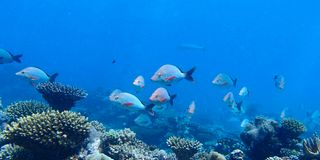Is blue carbon the ocean's hidden climate solution?

Coral reefs and fish in Indian Ocean.
What you need to know:
- Despite their immense value, blue carbon ecosystems face significant threats. Coastal development driven by urbanisation and industrialisation has led to widespread habitat loss.
The fight against climate change often brings to mind images of lush forests, wind turbines and solar panels. However, one of the most powerful yet overlooked tools in this battle lies beneath the waves: blue carbon.
Blue carbon is carbon captured and stored by ocean and coastal ecosystems, primarily mangroves, seagrasses and salt marshes.
These ecosystems are crucial in sequestering carbon dioxide (CO₂) from the atmosphere. They act as natural carbon sinks, absorbing and storing substantial amounts of carbon. Understanding blue carbon is essential for recognising its potential contributions to climate change mitigation, as well as its ecological and socio-economic benefits.
Among other solutions, blue carbon ecosystems have proven efficient at capturing carbon. Through photosynthesis, these plants absorb CO₂ and convert it into organic matter. Unlike terrestrial forests, where most carbon is stored in above-ground biomass, blue carbon ecosystems predominantly store their carbon in the soil beneath them. This soil can be several meters deep and can sequester carbon for centuries or even millennia if left undisturbed. For instance, mangrove soils can store up to four times more carbon per hectare than tropical forests.
Blue carbon ecosystems conservation and restoration is an ecological priority, critical for climate stability. When these ecosystems are degraded, the stored carbon is released back into the atmosphere as CO₂, exacerbating global warming. For example, clearing mangroves for aquaculture or urban expansion exposes the carbon-rich soils to oxygen, leading to accelerated decomposition and increased CO₂ emissions.
Beyond carbon sequestration, these ecosystems provide numerous additional benefits. They serve as vital habitats for various marine species, including fish and migratory birds. This trickles down to biodiversity and fisheries that millions rely on for sustenance and livelihoods. In regions like the Kenyan coast, mangroves act as essential breeding grounds for fish populations that sustain local fishing communities.
These ecosystems are also natural barriers against coastal erosion and extreme weather events. The dense root systems of mangroves can reduce wave energy by up to 66 per cent, offering protection to coastal communities from storm surges and rising sea levels, a critical consideration for many vulnerable regions around the world.
Economically, the ecosystems present opportunities for ecotourism and sustainable livelihoods. The Kenyan Gazi Bay mangrove initiative exemplifies community-led conservation efforts for tourism and income for residents.
Despite their immense value, blue carbon ecosystems face significant threats. Coastal development driven by urbanisation and industrialisation has led to widespread habitat loss. In Africa alone, the conversion of mangroves into shrimp farms or salt pans has resulted in severe degradation of these critical ecosystems. Additionally, pollution from agricultural runoff and plastic waste further compounds these challenges.
Climate change itself poses a dual threat to blue carbon ecosystems. Rising sea levels can overwhelm mangroves and seagrasses, while warmer ocean temperatures and acidification can affect their health and functionality. Seagrasses are particularly sensitive to changes in water quality. Their decline could have cascading impacts on marine biodiversity and overall ecosystem health.
A significant barrier to effectively leveraging blue carbon for climate mitigation is the lack of awareness and policy support at the national level. Many countries have yet to integrate blue carbon strategies into their climate action plans fully. This gap is partly due to the complexities involved in measuring and monitoring carbon storage within marine environments, compounded by limited funding available for conservation initiatives.
Fortunately, there is a growing global momentum towards protecting and restoring blue carbon ecosystems. Initiatives spearheaded by international organisations such as the United Nations and the International Union for Conservation of Nature (IUCN) aim to raise awareness about blue carbon's significance while promoting conservation efforts worldwide. The Blue Carbon Initiative exemplifies collaborative efforts involving governments, scientists, and local communities to develop policies that safeguard these vital ecosystems.
On a national scale, some countries are beginning to take proactive measures to conserve their blue carbon resources. For instance, Kenya's government has engaged in various mangrove restoration projects through its Marine and Fisheries Research Institute. Community-led initiatives like Mikoko Pamoja have demonstrated promising outcomes by selling carbon credits while simultaneously restoring mangrove habitats and funding local schools and water projects.
Non-governmental organisations are helping advance research on blue carbon ecosystems. Some NGOs across the globe have been instrumental in conducting studies to inform policy decisions regarding blue carbon conservation in the region.
Blue carbon’s role in addressing climate change cannot be overstated. Although these ecosystems cover less than two per cent of the ocean's surface area, they account for nearly half of all carbon stored in marine sediments. Preserving and restoring these habitats could significantly mitigate greenhouse gas emissions. Estimates suggest that conserving existing blue carbon ecosystems could prevent up to one billion tonnes of CO₂ from being released annually by 2050.
Integrating blue carbon strategies also aligns with international agreements like the Paris Agreement, which emphasises nature-based solutions for achieving net-zero emissions targets. Investing in blue carbon will aid countries in meeting their Nationally Determined Contributions and addressing local development needs through sustainable practices.

